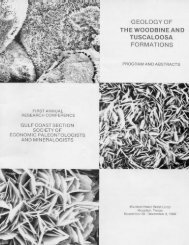Petroleum Systems of Deep-Water Basins - Gulf Coast Section SEPM
Petroleum Systems of Deep-Water Basins - Gulf Coast Section SEPM
Petroleum Systems of Deep-Water Basins - Gulf Coast Section SEPM
You also want an ePaper? Increase the reach of your titles
YUMPU automatically turns print PDFs into web optimized ePapers that Google loves.
Subsalt Exploration Trap Styles, Walker Ridge and<br />
Keathley Canyon Areas, <strong>Deep</strong> <strong>Water</strong> <strong>Gulf</strong> <strong>of</strong> Mexico<br />
Louis Liro<br />
e-mail: louis_liro@veritasdgc.com<br />
Nathan Weber<br />
Steve O’Hara<br />
Mo Etemadi<br />
Susan Lock Williams<br />
Mary Cubanski<br />
Veritas Exploration Services<br />
Veritas DGC<br />
10300 Town Park<br />
Houston, Texas USA 77072<br />
Mary Kadri<br />
Veritas Exploration Services<br />
2200, 715–5 th Avenue S.W.<br />
Calgary, Alberta Canada T2P5A2<br />
Peter Montecchi<br />
retired<br />
Abstract<br />
We describe the exploration plays associated with the salt nappe, canopy, and massif systems <strong>of</strong> Walker Ridge and<br />
Keathley Canyon areas in the deep water <strong>Gulf</strong> <strong>of</strong> Mexico. Depth imaging <strong>of</strong> 3D seismic allows definition <strong>of</strong> the salt<br />
emplacement and deformation history, and the associated subsalt trap styles.<br />
Salt emplacement in the region follows a simple history: relatively evenly spaced inferred paleo salt stocks have<br />
fed salt canopy, nappe, and massif systems. In this region, salt is emanating directly from the Jurassic Louan layer.<br />
Mapping <strong>of</strong> the salt allows division <strong>of</strong> the present–day salt masses into discrete salt “cells.” Emplacement and extrusion<br />
occurred in a series <strong>of</strong> low-angle and high-angle surfaces, dominantly lateral in the canopy and nappe systems,<br />
and dominantly vertical in the massif system.<br />
Subsalt structural traps are divided into three major types, from deepest to shallowest: (1) Anticlinal salt–cored<br />
folds <strong>of</strong> Mesozoic and Paleogene strata; (2) Structural inversions (“turtles”) <strong>of</strong> Paleogene and Neogene strata; and (3)<br />
Counterregional dip and truncation <strong>of</strong> Neogene strata against the vertical salt emplacement to lateral salt emplacement<br />
transition. Mesozoic anticlines are located basinward <strong>of</strong> a regional low in the Middle Cretaceous sequence<br />
boundary. These structures are fully detached from the superjacent lateral salt masses. These structures are on–trend<br />
with recent significant discoveries in more shallow waters. Structural inversions are associated with paleo salt stocks.<br />
Salt truncation traps are more shallow and <strong>of</strong>fset from the crest <strong>of</strong> the inversion structures. Definition <strong>of</strong> salt “cells”<br />
allows an understanding <strong>of</strong> the development <strong>of</strong> each structure in the trend, which may imply subtle differences in<br />
structural timing and trap competency prior to hydrocarbon emplacement.<br />
21

















